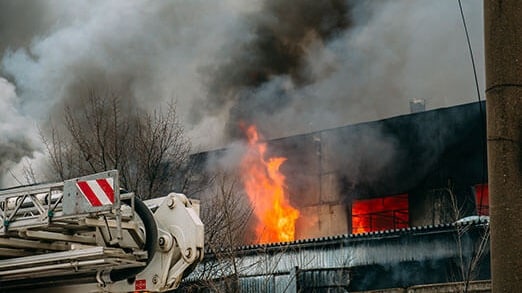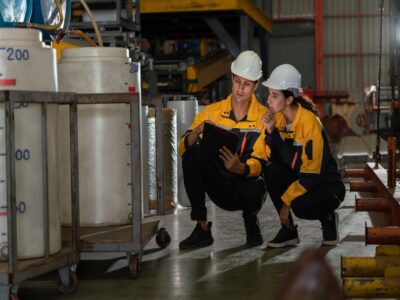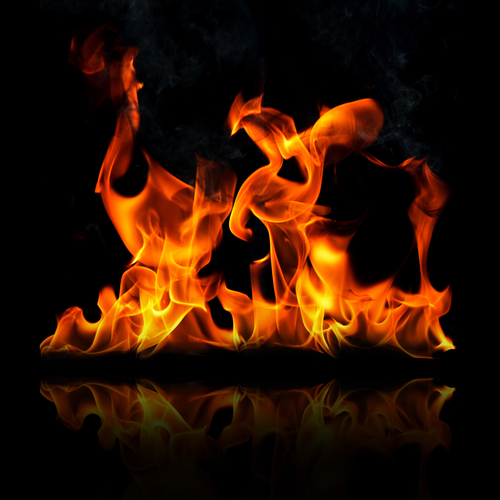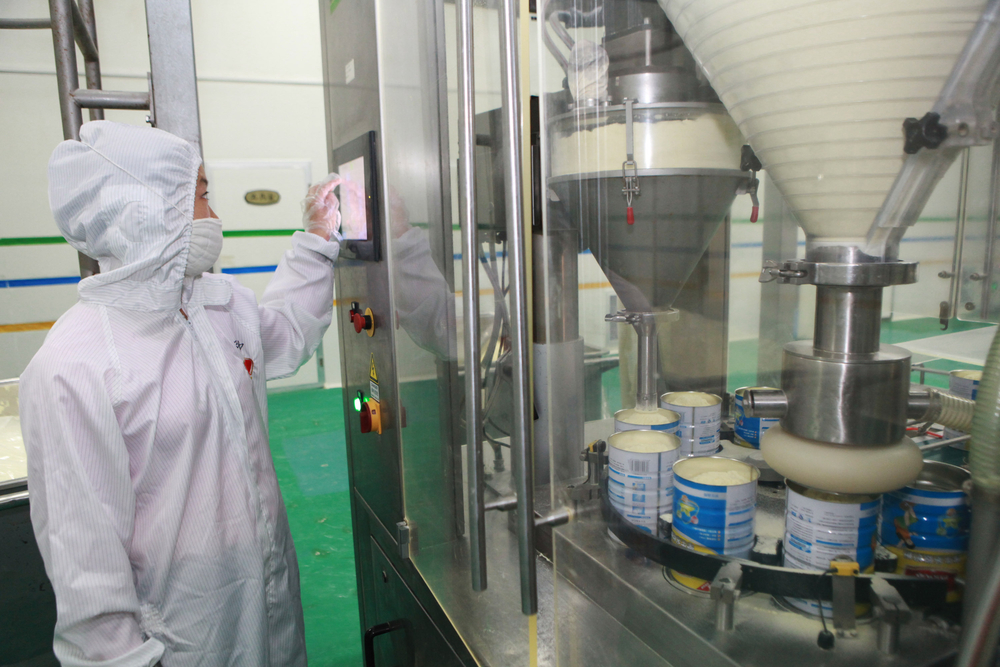Search
The Hidden Hazard of Thermal Instability in Powders – Preventing Fires and Explosions in Drying Operations Through Laboratory Testing (Part 1)

Industrial drying of powders is a common and essential process across multiple sectors, from chemical and pharmaceutical manufacturing to food production and detergents. However, beneath the apparent routine of drying operations lies a hidden hazard—thermal instability in powders.
When powders are exposed to heat, some can undergo self-heating/ exothermic decomposition, leading to thermal runaway where the powder temperature increases uncontrollably. If not properly assessed, the runaway can lead to fires, explosion, or release of hazardous decomposition products. Industrial drying equipment such as tray dryers, spray dryers, and fluidized bed dryers, can inadvertently create the perfect conditions for a thermal runaway incident.
Self-heating-initiated fires and explosions in drying operations are not just theoretical risks; they have occurred multiple times in industrial settings, often because powders seem to have behaved ‘unpredictably’ when subjected to heating. However, these supposedly unpredictable hazards are usually preventable—if they are properly identified, examined and understood before scale-up.
At Stonehouse, we emphasize the critical role of laboratory testing in identifying powder self-heating tendencies, decomposition risks, and safe drying and operating temperatures. This two-part article explores the risks of thermal decomposition in powders and how a structured testing protocol can eliminate hazards before they lead to an incident.
In this Part 1 of the Article, we will discuss:
- Example Study: Thermal instability in spray driers
- The science behind thermal decomposition and runaway reactions—why powders self-heat, decompose, and sometimes ignite.
- Why early-stage testing is crucial before powders are subjected to industrial drying conditions.
Next month, in Part 2 (to be featured in Process Safety Dispatch), we will explore the laboratory screening methods that help assess thermal risks—particularly “Bulk Powder”, “Aerated Powder”, and “Powder Layer” tests—and explain how they enable process engineers to optimally control drying temperature and exposure time to prevent incident.
Oh, and because we understand that not everyone is dealing with powder thermal instability every day, we’ve provided you with a glossary of terms at the end – to help you get the most out of this article.
Enjoy!
Example Study: Thermal Instability in Spray Drying Operations
By way of example of how self-heating happens in dryers, we chose one specific type of dryer – the spray dryer. We could equally have chosen any of the other dryer types we mentioned above.
The process
Spray drying transforms a feed of liquid (emulsion or solution) or slurry (a semi-liquid mixture of fine solid particles and a liquid) into fine powder through rapid evaporation in a hot airstream. While efficient, this process introduces significant fire and explosion hazards—especially from the self-heating of powders.
Initially, water-based atomised droplets usually pose no self-heating hazard. But as they dry into particles, they become increasingly susceptible to ignition. In many spray dryers, particularly those using rotary atomisers or counter-current airflow, turbulence can suspend these dry particles throughout the chamber. Under the right conditions, an explosible dust cloud forms—vulnerable to ignition.
A major concern is the accumulation of dry powder, for example in the lower areas of the dryer or in the recovery system. Additionally, if discharge is restricted or blocked, powder can build up. Over time, the accumulated powder may undergo an exothermic reaction (usually an oxidative decomposition). If the heat isn’t dissipated quickly enough, it builds up, causing the powder to self-heat. With sufficient insulation and retention, the temperature can rise to the point of ignition. Such fires often begin unnoticed in the dryer and may escalate rapidly causing a fire and igniting any dispersed dust suspended above, causing an explosion.
Material deposits on chamber walls and ceiling—especially near hot liquid or slurry entry zones—can also self-heat and ignite if not regularly removed. Once alight, these deposits can dislodge, falling onto powder beds or igniting airborne dust.
Examples
Here are a few examples of materials that have caused fires and/ or explosions in spray drying processes:
- Whey Powder / Milk Powders (Food Industry)
Cause: Build-up of product deposits or bulk powder at the base undergoes slow oxidation or thermal decomposition when airflow or discharge restricted.
Outcome: Several serious fires, some leading to explosions, have occurred due to unnoticed smouldering of powder heaps.
- Lactose
Cause: Lactose caramelises or decomposes when exposed to high temperatures or if airflow is insufficient, particularly during shutdown.
Outcome: Fires in the base of dryers or powder conveying systems.
- Cellulose Derivatives (e.g., Methylcellulose, Hydroxypropylcellulose)
Cause: Thermally unstable under certain conditions; decomposition initiates at lower-than-expected temperatures.
Outcome: Causes fires in dryer chambers and cyclones due to powder self-heating.
- Pharmaceutical Intermediates
Cause: Some compounds have low decomposition onset temperatures or are reactive.
Outcome: Explosions occur when scaling-up to production levels, or when operating near thermal limits.
Thermal Decomposition: What Happens When Powders Heat Up?
Thermal decomposition occurs when a powder breaks down due to heat exposure, often releasing heat and gases, which may or may not be flammable. This decomposition process can be slow and localized or rapid and uncontrollable, depending on the material’s chemical properties and drying/ heating conditions.
A generic equation for exothermic decomposition of an organic powder might look like this:
CxHyOz + O2 → CO2 + H2O + heat
But in oxygen limited conditions (often the case within powders in bulk) partial oxidation or pyrolysis is to be expected:
CxHyOz → Volatile organics + Carbonaceous residue (char) + heat
Once heat begins to be generated there is another important equation to note. The Arrhenius equation describes how the rate of exothermic decomposition of a powder increases exponentially with temperature, helping predict the conditions under which self-heating or ignition may occur.
k = A e -Ea / (RT)
Where:
k = reaction rate constant
A = pre-exponential factor (frequency of collisions)
Ea = activation energy (J/mol)
R = universal gas constant (8.314 J/mol·K)
T = absolute temperature (K)
So, we see that the key factors influencing thermal decomposition risk include:
Chemical Composition – Organic powders (e.g., food ingredients, pharmaceuticals) will often release gases and/ or char when heated, while metal powders can undergo slow or sometimes very fast oxidation reactions, depending on conditions.
Temperature Sensitivity – Some powders begin breaking down at surprisingly low temperatures – even below room temperature in some cases.
Time – Exothermic reactions are usually temperature dependent, meaning runaway often starts slowly and accelerates as temperature increases. The time to thermal runaway onset temperature is an important parameter to establish.
Moisture Content – The presence of moisture can sometimes delay decomposition but may also create conditions for exothermic reactions.
Particle Size and Distribution – Fine powders might react and heat up more rapidly due to higher surface area and might have the ability to retain generated heat due to the absence of voids between particles.
Oxygen availability – With oxidation reactions, the rate of reaction (and therefore rate of heat generation) will be affected by air availability. In bulked powder, oxygen is often naturally limited which will slow down the reaction. This effect works counter to the particle size and distribution effect above.
In industrial drying and other situations where the powder might be heated up inadvertently, this exothermic decomposition can trigger runaway reactions if heat is not dissipated quickly enough.
Thermal Runaway in Drying Operations
So, we ‘ve look at the rate of heat generation (Qgen) side of thermal decomposition; now we consider rate of heat loss (Qloss) to complete the story.
Runaway occurs when:
Qgen > Qloss
| In simple words, an uncontrolled runaway event occurs when heat is generated at a faster rate than it can dissipate |
- As we know, the reaction rate increases with temperature; as heat builds up, decomposition speeds up, generating even more heat. Refer to the Arrhenius equation to describe how temperature increases rate of reaction above. It’s exponential.
- Once thermal runaway begins, external intervention can rarely stop the cycle; without active cooling, thermal runaway will progress until ignition or explosion occurs.
This runaway cycle is especially dangerous in drying operations, where powders are often exposed to prolonged heat. Many industrial dryers trap heat in bulk powder accumulations or powder layers, further increasing the risk of self-heating and runaway decomposition. The thicker the accumulated layer or the bigger the bulked volume, the lower the exotherm onset temperature will likely be. This danger is not just in the dryer itself, but it can also be in other downstream processing equipment, storage vessels, bins or bags.
Why Thermal Characterization is Essential in Powder Drying and Processing
Not all powders behave predictably under heat – both regarding rate of heat generation and rate of heat loss. The first logical step is therefore screening to identify hazardous powders before they are dried or processed at industrial scale. The only reliable way to do this is through thermal characterization testing that simulates the heating conditions in the specific type of dryer to be used. Once hazards are identified they can be accurately quantified by further tests.
What Does Thermal Characterization Testing Reveal?
By subjecting powders to controlled heating conditions, laboratory tests can determine:
- Self-heating onset temperatures – The lowest temperature at which a powder starts thermally breaking down under specific conditions.
- Self-heating behavior over time – Whether the material can generate heat internally under typical drying and processing conditions and over what time period.
- Exothermic reaction severity – How quickly the powder temperature will rise during decomposition and will it catch fire.
- Gas evolution – Whether powder heating leads to the release of gases, and if those gases are combustible or inert – increasing explosion risk.
By conducting these tests before scale-up, manufacturers can select dryer type or adjust drying conditions to ensure safety.
Good laboratory testing can explore and simulate different large-scale powder drying and processing and provide process engineers with the data they need to allow them to establish:
- Safe drying temperature limits
- Maximum allowable residence times in the dryer
- Powder handling precautions (e.g., avoiding bulk accumulations, cooling, storage time and conditions, using inert atmospheres)
We’ll look in Part 2 of this article in more detail at the different powder tests available and how to interpret their results to ensure safe drying conditions for different dryer types.
So, Stay tuned for the next edition of Process Safety Dispatch to learn how to ensure your powders can be safely dried—without the risk of fire or explosion.
Glossary of terms
- Thermal instability: The tendency of a powder to undergo chemical changes when heated, potentially leading to hazardous reactions such as decomposition or combustion.
- Exothermic reaction: A chemical reaction that releases heat. In powders, this can cause a rise in temperature and potentially trigger further reactions.
- Exothermic decomposition: A type of exothermic reaction where a substance breaks down into simpler components, releasing heat. This can lead to dangerous pressure and temperature increases in powders.
- Exotherm onset temperature: The temperature at which an exothermic reaction begins. It’s a critical threshold in assessing powder stability.
- Self-heating: When a powder generates heat internally through slow exothermic reactions, which can lead to further temperature rise without external heating.
- Thermal runaway: A dangerous condition where heat from a reaction causes the temperature to rise uncontrollably, accelerating the reaction and potentially leading to fire or explosion.
- Chemical reaction: A process where substances (reactants) transform into different substances (products). In powders, unwanted reactions can occur under heat, pressure, or contamination, posing safety risks.
End of Part 1

Get in touch
To learn more about our expertise and services in dust explosion prevention & mitigation, call us at +1 609 455 0001 or email us at [email protected] today.
We also offer tailored virtual and in-company process safety training programs on Dust Explosions, Static Electricity and HAC (Hazardous Area Classification) and more. Find further information here.










